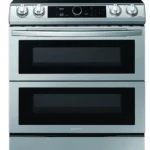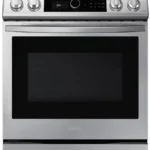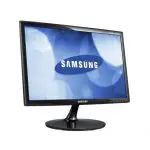

SAMSUNG AC009BNNDCH Air Conditioner

Safety Information
Cancer and Reproductive Harm – www.P65Warnings.ca.gov.
Before using your new air conditioner, please read this manual thoroughly to ensure that you know how to safely and efficiently operate the extensive features and functions of your new appliance.
Because the following operating instructions cover various models, the characteristics of your air conditioner may differ slightly from those described in this manual. If you have any questions, call your nearest contact centre or find help and information online at www.samsunghvac.com.
WARNING
Hazards or unsafe practices that may result in severe personal injury or death.
CAUTION
Hazards or unsafe practices that may result in minor personal injury or property damage.
FOR INSTALLATION
WARNING
Use the power line with the power specifications of the product or higher and use the power line for this appliance only. In addition, do not use an extension line.
- Extending the power line may result in electric shock or fire.
- Do not use an electric transformer. It may result in electric shock or fire.
- If the voltage/frequency/rated current condition is different, it may cause fire.
The installation of this appliance must be performed by a qualified technician or service company.
- Failing to do so may result in electric shock, fire, explosion, problems with the product, or injury and may also void warranty on the installed product.
Install a switch and circuit breaker dedicated to the air conditioner.
- Failing to do so may result in electric shock or fire.
Fix the outdoor unit firmly so that the electric part of the outdoor unit is not exposed.
- Failing to do so may result in electric shock or fire, explosion, or problems with the product.
Do not install this appliance near a heater, inflammable material. Do not install this appliance in a humid, oily or dusty location, in a location exposed to direct sunlight and water (rain drops). Do not install this appliance in a location where gas may leak.
- This may result in electric shock or fire.
Never install the outdoor unit in a location such as on a high external wall where it could fall.
- If the outdoor unit falls, it may result in injury, death or property damage.
This appliance must be properly grounded. Do not ground the appliance to a gas pipe, plastic water pipe, or telephone line.
- Failure to do so may result in electric shock, fire, an explosion, or other problems with the product.
CAUTION
Install your appliance on a level and hard floor that can support its weight.
- Failing to do so may result in abnormal vibrations, noise, or problems with the product.
Install the draining hose properly so that water is drained correctly.
- Failing to do so may result in water overflowing and property damage. Avoid adding drain to waste pipes as odors may arise in the future.
When installing the outdoor unit, make sure to connect the draining hose so that draining is performed correctly.
- The water generated during the heating operation by the outdoor unit may overflow and result in property damage. In particular, in winter, if a block of ice falls, it may result in injury, death or property damage.
FOR POWER SUPPLY
WARNING
When the circuit breaker is damaged, contact your nearest service Centre.
Do not pull or excessively bend the power line. Do not twist or tie the power line. Do not hook the power line over a metal object, place a heavy object on the power line, insert the power line between objects, or push the power line into the space behind the appliance.
- This may result in electric shock or fire.
CAUTION
When not using the air conditioner for a long period of time or during a thunder/lightning storm, cut the power at the circuit breaker.
- Failing to do so may result in electric shock or fire.
FOR USING
WARNING
If the appliance is flooded, please contact your nearest service Centre.
- Failing to do so may result in electric shock or fire.
If the appliance generates a strange noise, a burning smell or smoke, cut-off the power supply immediately and contact the nearest service center.
- Failing to do so may result in electric shock or fire.
In the event of a gas leak (such as propane gas, LP gas, etc.), ventilate immediately without touching the power line. Do not touch the appliance or power line.
- Do not use a ventilating fan.
- A spark may result in an explosion or fire.
To reinstall the air conditioner, please contact your nearest service Centre.
- Failing to do so may result in problems with the product, water leakage, electric shock, or fire.
- A delivery service for the product is not provided. If you reinstall the product in another location, additional construction expenses and an installation fee will be charged.
- Especially, when you wish to install the product in an unusual location such as in an industrial area or near the seaside where it is exposed to the salt in the air, please contact your nearest service Centre.
Do not touch the circuit breaker with wet hands.
- This may result in electric shock.
Do not turn the air conditioner off with the circuit breaker while it is operating.
- Turning the air conditioner off and then on again with the circuit breaker may cause a spark and result in electric shock or fire.
After unpacking the air conditioner, keep all packaging materials well out of the reach of children, as packaging materials can be dangerous to children.
- If a child places a bag over its head, it may result in suffocation.
Do not touch the front panel with your hands or fingers during the heating operation.
- This may result in electric shock or burns.
Do not insert your fingers or foreign substances into the outlet when the air conditioner is operating or the front panel is closing.
- Take special care that children do not injure themselves by inserting their fingers into the product.
Do not insert your fingers or foreign substances into the air inlet/outlet of the air conditioner.
- Take special care that children do not injure themselves by inserting their fingers into the product.
Do not strike or pull the air conditioner with excessive force.
- This may result in fire, injury, or problems with the product.
Do not place an object near the outdoor unit that allows children to climb onto the machine.
- This may result in children seriously injuring themselves.
Do not use this air conditioner for long periods of time in badly ventilated locations or near infirm people.
- Since this may be dangerous due to a lack of oxygen, open a window at least once an hour.
If any foreign substance such as water has entered the appliance, cut-off the power supply and contact the nearest service center.
- Failing to do so may result in electric shock or fire.
Do not attempt to repair, disassemble, or modify the appliance yourself.
- Do not use any fuse (such as copper, steel wire, etc.)other than the standard fuse.
- Failing to do so may result in electric shock, fire, problems with the product, or injury.
CAUTION
Do not place objects or devices under the indoor unit.
- Water dripping from the indoor unit may result in fire or property damage.
Check that the installation frame of the outdoor unit is not broken at least once a year.
- Failing to do so may result in injury, death or property damage.
Max current is measured according to IEC standard for safety and current is measured according to ISO standard for energy efficiency.
Do not stand on top of the appliance or place objects (such as laundry, lighted candles, lighted cigarettes, dishes, chemicals, metal objects, etc.) on the appliance.
- This may result in electric shock, fire, problems with the product, or injury.
Do not operate the appliance with wet hands.
- This may result in electric shock.
Do not spray volatile material such as insecticide onto the surface of the appliance.
- As well as being harmful to humans, it may also result in electric shock, fire or problems with the product.
Do not drink the water from the air conditioner.
- The water may be harmful to humans.
Do not apply a strong impact to the remote controller and do not disassemble the remote controller.
Do not touch the pipes connected with the product.
- This may result in burns or injury.
Do not use this air conditioner to preserve precision equipment, food, animals, plants or cosmetics, or for any other unusual purposes.
- This may result in property damage.
Avoid directly exposing humans, animals or plants from the air flow from the air conditioner for long periods of time.
- This may result in harm to humans, animals or plants.
This appliance is not intended for use by persons (including children) with reduced physical, sensory or mental capabilities, or lack of experience and knowledge, unless they have been given supervision or instruction concerning use of the appliance by a person responsible for their safety. Children should be supervised to ensure that they do not play with the appliance.
FOR CLEANING
WARNING
Do not clean the appliance by spraying water directly onto it. Do not use benzene, thinner, alcohol or acetone to clean the appliance.
- This may result in discoloration, deformation, damage, electric shock or fire.
Before cleaning or performing maintenance, cut-off the power supply and wait until the fan stops.
- Failing to do so may result in electric shock or fire.
CAUTION
Take care when cleaning the surface of the heat exchanger of the outdoor unit since it has sharp edges.
- To avoid cutting your fingers, wear thick cotton gloves when cleaning it.
- This should be done by a qualified technician please contact your installer or service Centre.
Do not clean the inside of the air conditioner by yourself.
- For cleaning inside the appliance, contact your nearest service Centre.
- When cleaning the internal filter, refer to the descriptions in the ‘Cleaning and Maintaining’ section.
- Failure to do may result in damage, electric shock or fire.
Indoor Unit Overview
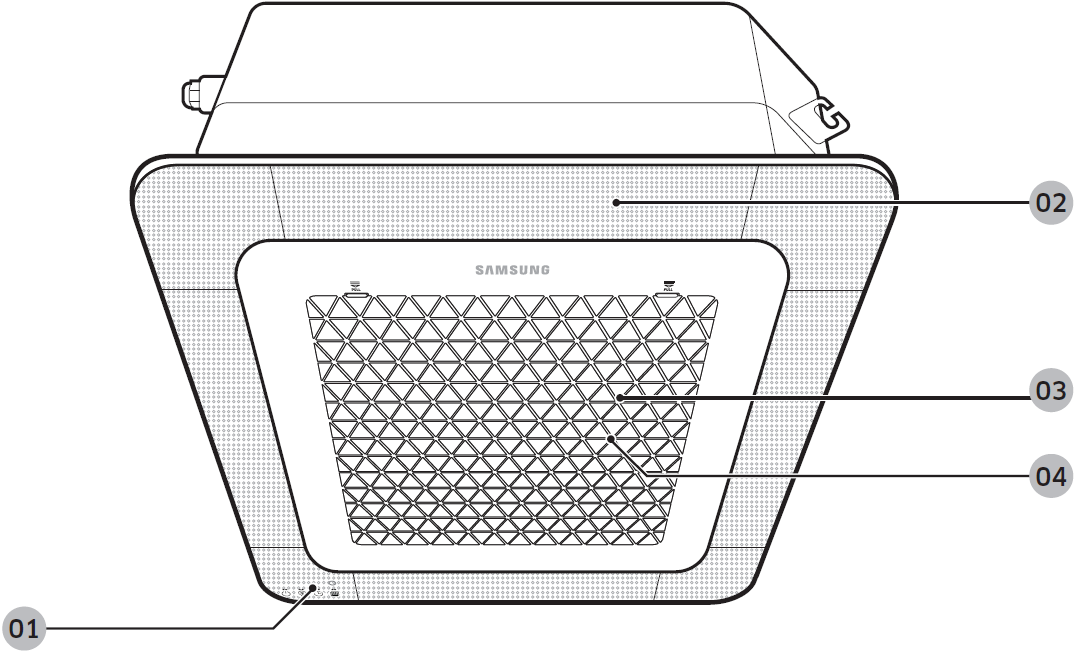
- Display

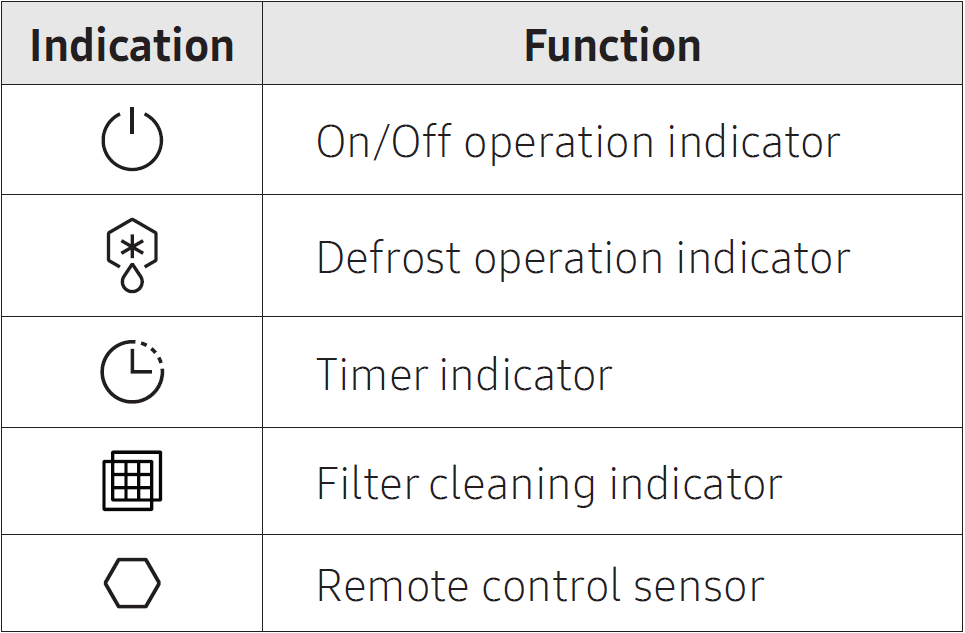
- Air Flow Blade / Air Outlet (Inside) / Wind-Free Panel
You can use the Wind-Free Cooling function when the Cool, Dry, or Fan mode is running. (Refer to the remote control manual for product operation.) - Air Intake
- Air Filter (Under the Grille)
Operation Features
Operating Temperature and Humidity
When using the air conditioner follow the operating temperature and humidity ranges. Indoor unit / Outdoor unit : AC***BN*DCH / AC***BXADCH
| Mode | Indoor Temperature | Outdoor Temperature | Indoor Humidity | If Out of Conditions |
| Cooling | 64°F to 90°F (18°C to 32°C) |
0 °F to 122 °F (-18 °C to 50 °C) |
80% or less | Condensation may occur on the indoor unit with risk to have either water blow off or drops on the floor.
Internal protection triggers and the air conditioner will stop. |
| Drying | 64°F to 90°F (18°C to 32°C) |
0 °F to 122 °F (-18 °C to 50 °C) |
80% or less | |
| Heating | 86°F or less (30°C or less) |
-13 °F to 75 °F (-25 °C to 24 °C ) |
– | Internal protection triggers and the air conditioner will stop. |
Indoor unit / Outdoor unit : AC***BN*DCH / AJ***BX**CH
| Mode | Indoor Temperature | Outdoor Temperature | Indoor Humidity | If Out of Conditions |
| Cooling | 64°F to 90°F (18°C to 32°C) |
Depending on the outdoor unit specifications | 80% or less | Condensation may occur on the indoor unit with risk to have either water blow off or drops on the floor.
Internal protection triggers and the air conditioner will stop. |
| Drying | 64°F to 90°F (18°C to 32°C) |
80% or less | ||
| Heating | 86°F or less (30°C or less) |
– | Internal protection triggers and the air conditioner will stop. |
CAUTION
- If you use the air conditioner at a relative humidity above 80%, it may cause a formation of condensation and a leakage of water on the floor.
- The standardized temperature for heating is 45°F (7°C). If the outdoor temperature drops to 32°F (0°C) or below, the heating capacity can be reduced depending on the temperature condition. If the cooling operation is used at over 90°F (32°C) (indoor temperature), it does not cool at its full capacity.
- If the indoor unit is out of the operating temperature and humidity range, the safety device may operate and the air conditioner may stops.
Cleaning and Maintaining
Before cleaning the indoor unit, be sure to turn off the auxiliary power switch.
Cleaning the Indoor Unit Exterior
Wipe the surface of the unit with a slightly wet or dry cloth when needed. Wipe off dirt of odd-shaped areas by using a soft brush.

CAUTION
- Do not use alkaline detergent, sulphury acid, hydrochloric acid, or organic solvents (such as thinner, kerosene, and acetone) to clean the surfaces.
- Do not attach any stickers on the surfaces because this may cause damage.
- When you clean the heat exchanger on the indoor unit, you need to disassemble the indoor unit. Therefore, you must contact the local service center for help.
Cleaning the Outdoor Unit Heat Exchanger
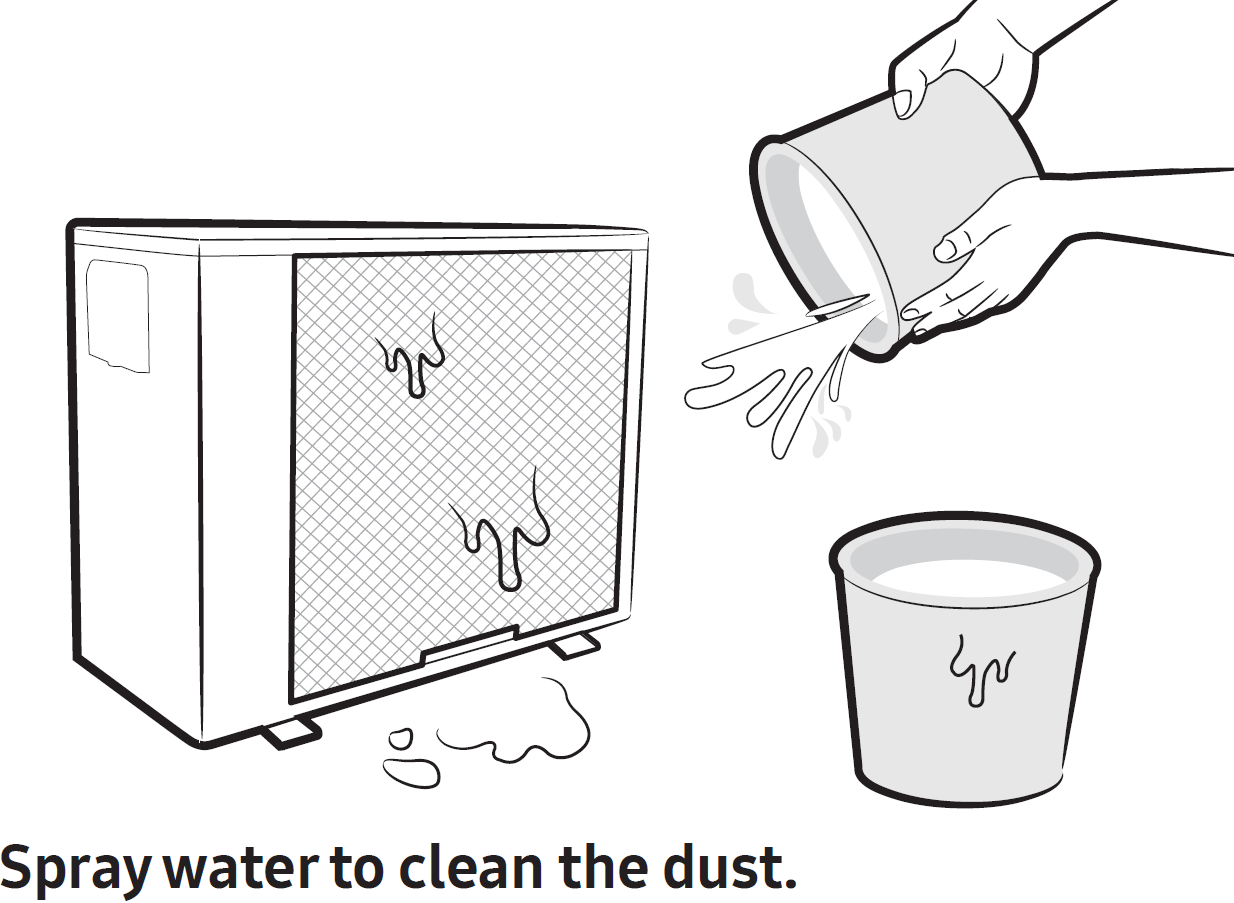
CAUTION
- The heat exchanger of the outdoor unit has sharp edges. Take care when cleaning its surface.
NOTE
- If it is difficult to clean the heat exchanger of the outdoor unit, contact the local service center.
Cleaning the Air Filter
CAUTION
- Before cleaning the indoor unit, be sure to turn off the auxiliary power switch.
- Be sure to support the grille when opening to prevent the grille from dropping.
- Detaching the Air Filter
Push down the hooks at each side of the front grille to open the grille.
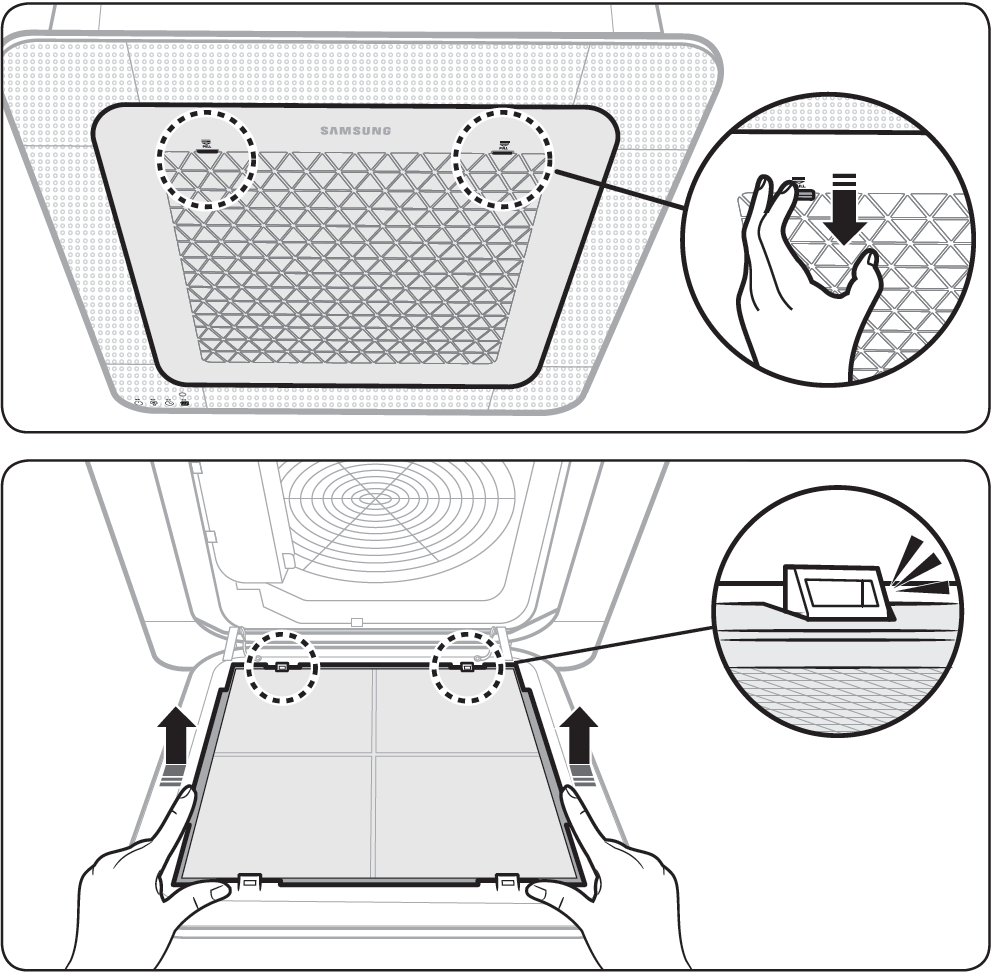
- Cleaning the Air Filter
Clean the air filter with a vacuum cleaner or soft brush. If dust is too heavy, then rinse it with running water and dry it in a ventilated area.
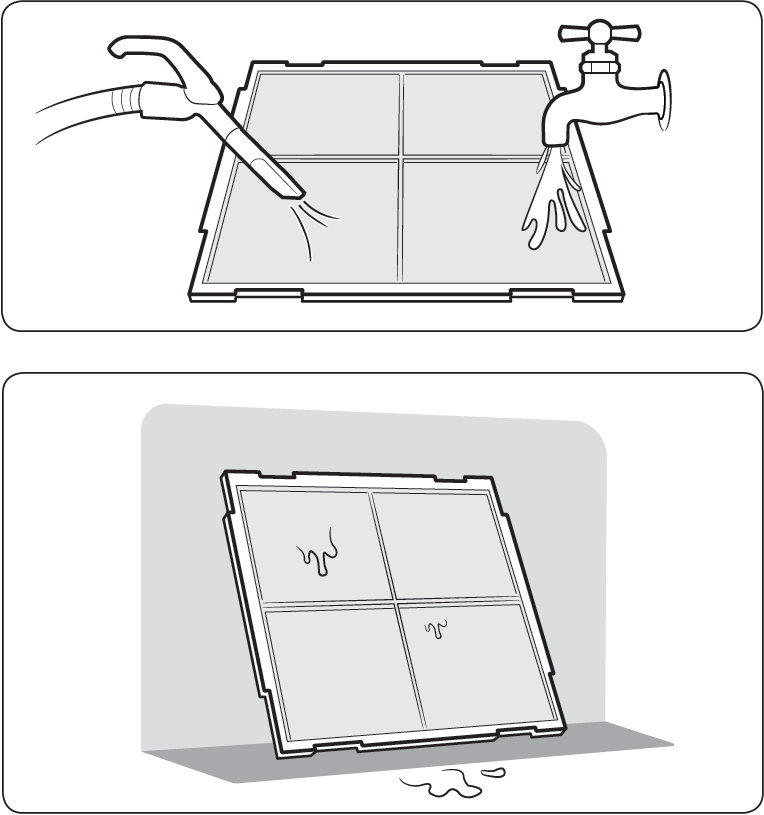
Note:- If the air filter dries in a humid area, it may produce offensive odors. Clean it again and dry it in a well-ventilated area.
- The cleaning period may differ depending on the usage and environmental conditions, so clean the air filter every week if the indoor unit is in the dusty area.
- You can request a filter cleaning service. Note that it is a charged service.
- Reassembling the Air Filter
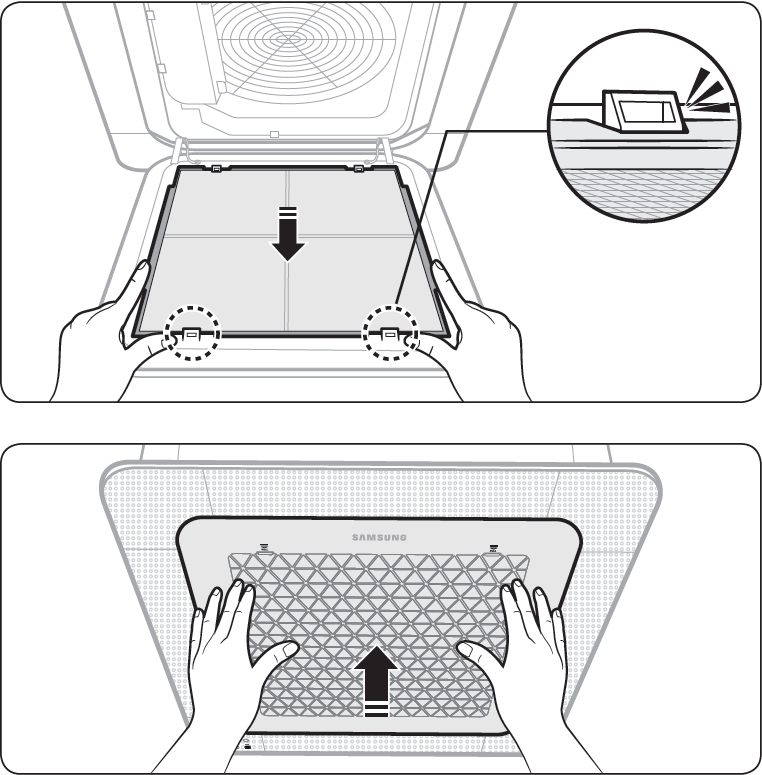
- Resetting the air filter (Wired remote control is an optional item)
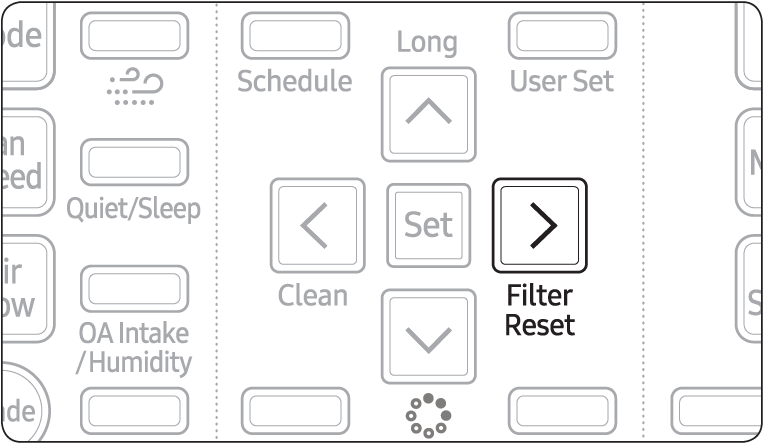

After cleaning and reassembling the air filter, be sure to reset the filter-cleaning reminder as follows:- Indoor unit with the wired remote control: Press the Filter Reset button.
- Indoor unit with the wireless remote control: Press the Options button → < or > → (Filter Reset) Blinking → press the SET button.
NOTE
- The filter reset indicator blinks when the air filter should be cleaned.
- Although the filter cleaning indicator does not light, be sure to press the “Filter Reset” button after cleaning the dust filter.
- If the angle of the air flow blade is changed by opening the front grille for installation or maintenance of the indoor unit, be sure to turn off and then on the auxiliary switch before operating the indoor unit again. If not, the angle of the air flow blade may be changed and the blades may not be closed after turning off the indoor unit.
Periodical Maintenance
| Unit | Maintenance Item | Interval | Requires Qualified Technicians |
| Indoor unit | Clean the air filter. | At least once a month | |
| Clean the condensate drain pan. | Once a year | Required | |
| Clean the heat exchanger | Once a year | Required | |
| Clean the condensate drain pipe. | Once every 4 months | Required | |
| Replace the remote control batteries. | At least once a year | ||
| Outdoor unit | Clean the heat exchanger on the outside of the unit. | Once every 4 months | Required |
| Clean the heat exchanger on the inside of the unit. | Once a year | Required | |
| Clean the electric components with jets of air. | Once a year | Required | |
| Verify that all the electric components are firmly tightened. | Once a year | Required | |
| Clean the fan. | Once a year | Required | |
| Verify that the fan assemblies are firmly tightened. | Once a year | Required | |
| Clean the condensate drain pan. | Once a year | Required |
Troubleshooting
Refer to the following chart if the air conditioner operates abnormally. This may save time and unnecessary expense.
| Problem | Solution |
| The air conditioner does not operate immediately after it has been restarted. |
|
| The air conditioner does not operate at all. |
NOTE
|
| The temperature does not change. |
|
| Warm air does not come out of the air conditioner. |
|
| The fan speed does not change. |
|
| The wireless remote control does not operate. |
|
| The wired remote control does not operate. |
|
| The air conditioner is not turned on or off immediately with the wired remote control. |
|
| The Timed on/off function does not operate. |
|
| The indoor unit display blinks continuously. |
|
| I want to get cooler air. |
|
| The air is not cool or warm enough. |
|
| The air is not cool or warm enough. |
|
| The air conditioner makes strange noises. |
|
| Unpleasant odors permeate the room. |
|
| Steam is produced on the indoor unit. |
|
| The outdoor unit fan continues to operate when the air conditioner is turned off. |
|
| Water drops from the piping connections of the outdoor unit. |
|
| Steam is produced on the outdoor unit. |
|
